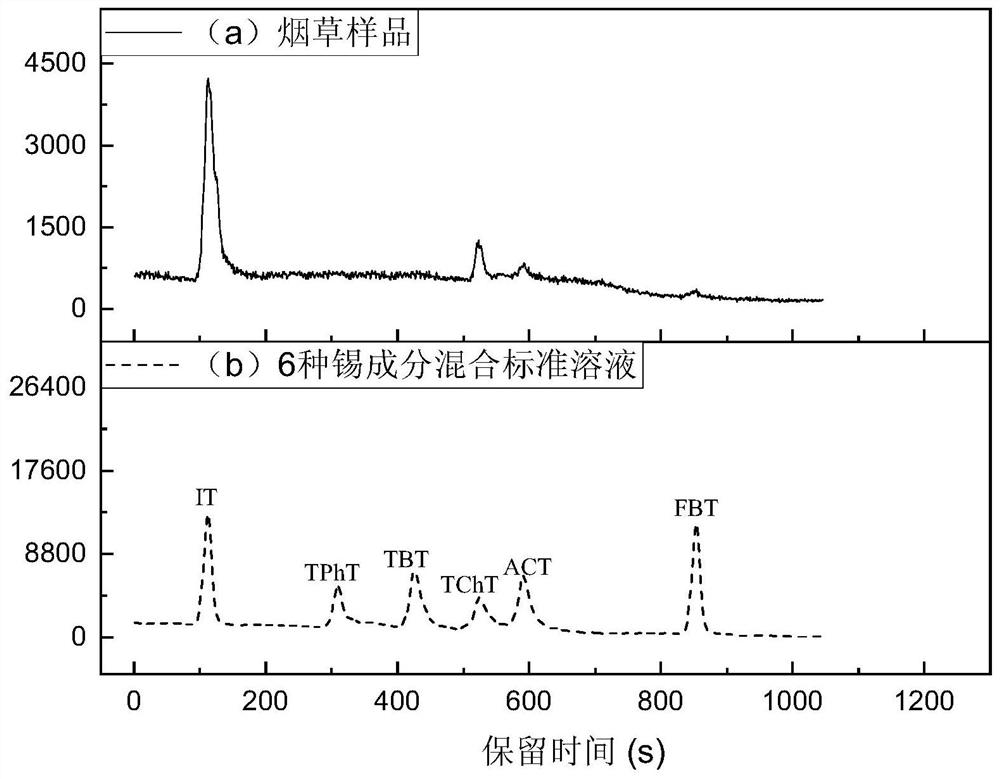Method for simultaneously separating and determining various organic tin and inorganic tin in tobacco
A simultaneous separation and organotin technology, applied in the field of chromatographic analysis and detection, can solve the problems of chromatographic peak tailing, passivation, inability to obtain accurate and reliable quantitative results, etc.
- Summary
- Abstract
- Description
- Claims
- Application Information
AI Technical Summary
Problems solved by technology
Method used
Image
Examples
Embodiment 1
[0100] 1. Sample pretreatment
[0101] Grind the tobacco sample with a heavy metal special grinder and pass it through a 100-mesh sieve. After balancing for 24 hours in a constant temperature and humidity box with a temperature of (22±1)°C and a relative humidity of (60±2)%, accurately weigh 1g ( Accurate to 0.001g) Tobacco samples in 60mL PET vials, add 10mL of extracting solution, vortex and shake at 50°C for 20min, centrifuge at 3500r / min for 10min, take the supernatant, and concentrate to 1mL by nitrogen blowing . Then filter through a 0.22 μm organic syringe filter to obtain the sample solution. During the processing of tobacco samples, a blank control test was performed simultaneously.
[0102] Wherein, the ratio of the mass (g) of the tobacco sample added to the volume (mL) of the extract is 1:10. The extract is solution A and solution B with a volume ratio of 1:1, wherein solution A is a mixed solution of citric acid, water, and ammonia with a mass ratio of 100:70:0...
Embodiment 2
[0126] As shown in 2 of Example 1 above, accurately pipette the organotin mixed standard stock solution and the inorganic tin standard stock solution respectively, add the extract and dilute to constant volume to prepare a series of mixed standard solutions with different concentrations. In the same mixed standard solution, the contained triphenyltin (TPhT), tributyltin (TBT), tricyclohexyltin (TChT), triazotin (ACT), fenbutyltin (FBT), tin element (Sn) The concentrations are all at the same concentration, that is, a series of mixed standard solutions of 0.5μg / L, 2.0μg / L, 5.0μg / L, 20.0μg / L, 50.0μg / L, and 200.0μg / L were prepared respectively . At the same time, the extract was added to prepare a solution with the concentration of 0 μg / L of the six organic tin and inorganic tin components as a solvent blank.
[0127] A series of mixed standard solutions with different concentrations prepared above were analyzed by high-performance liquid chromatography-inductively coupled plasm...
Embodiment 3
[0133] According to the pretreatment and measurement steps in Example 1, select the low, medium and high three standard addition levels of the tobacco sample, and carry out the mensuration of the sample standard addition recovery rate, and the standard addition amounts are respectively 10ng / g, 50ng / g, 200ng / g, The corresponding recoveries are shown in Table 4. The recovery rate was calculated by the difference between the concentration of the known sample and the spiked sample relative to the amount of the spiked sample, and the recovery rate was between 72.6 and 96.4%, and the recovery rate of the six forms of tin components was better.
[0134] Simultaneously, the recoveries of 6 kinds of tin components of morphologies are continuously carried out 6 parallel determinations, and the corresponding relative standard deviation data are shown in Table 4. The relative standard deviations (RSD) of 6 kinds of morphological tin components are all below 8.0%, illustrating the precision...
PUM
 Login to View More
Login to View More Abstract
Description
Claims
Application Information
 Login to View More
Login to View More - R&D
- Intellectual Property
- Life Sciences
- Materials
- Tech Scout
- Unparalleled Data Quality
- Higher Quality Content
- 60% Fewer Hallucinations
Browse by: Latest US Patents, China's latest patents, Technical Efficacy Thesaurus, Application Domain, Technology Topic, Popular Technical Reports.
© 2025 PatSnap. All rights reserved.Legal|Privacy policy|Modern Slavery Act Transparency Statement|Sitemap|About US| Contact US: help@patsnap.com



